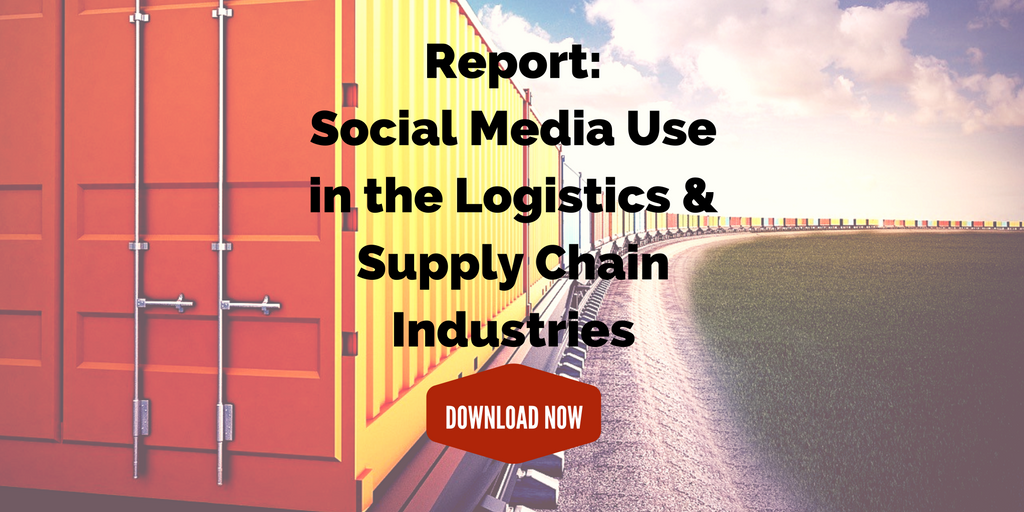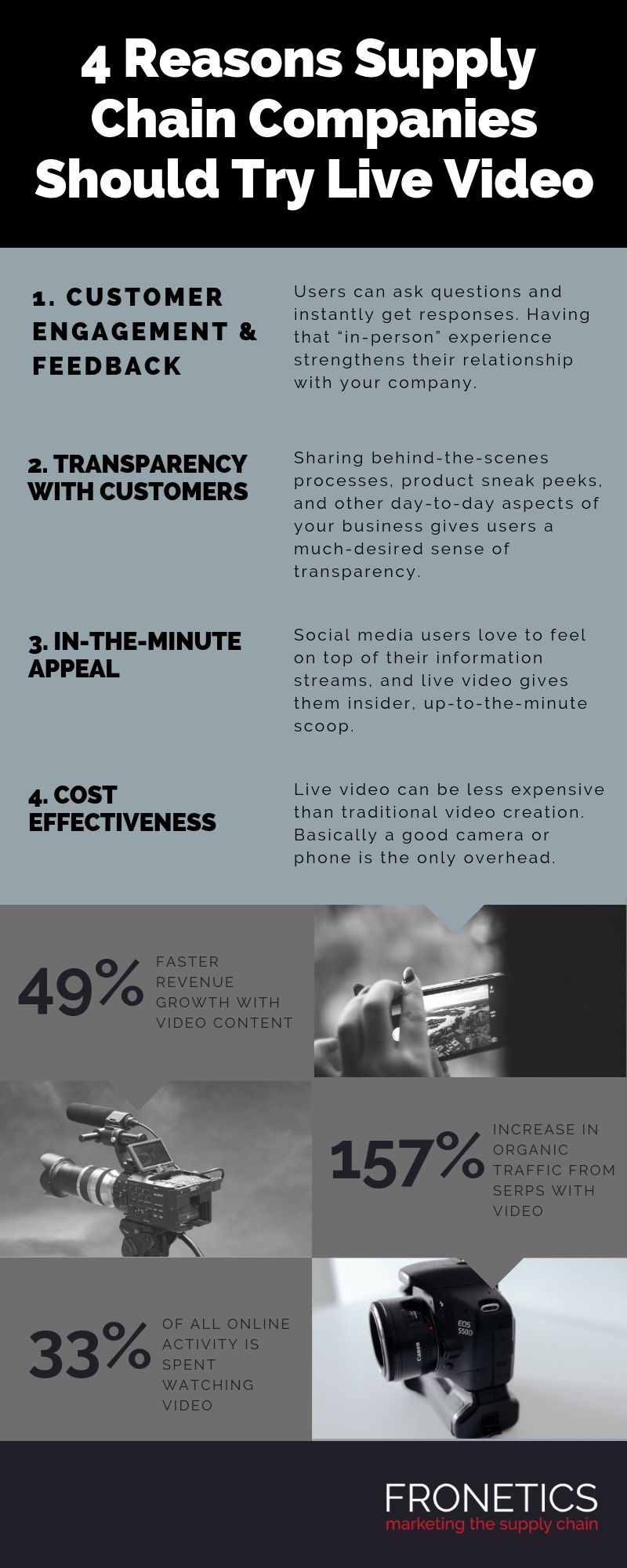
by Fronetics | Jan 10, 2019 | Blog, Content Marketing, Marketing, Supply Chain
With the start of the new year, it’s time to take a breath and get ready for what’s next. Here are five trends in supply chain marketing to expect in 2019.
Highlights:
- People trust people, not ads.
- Knowing how your customers communicate is key.
- Personal connection is the key to success.
There are a lot of sales and marketing speakers already shouting out the trends for 2019. It’s a fast-paced world, and it can be tough to tune out the noise and maintain your identity in the constantly shifting marketing landscape.
The best way to navigate all the changes and trends is to plan ahead and be aware of what’s in the pipeline. Here are five supply chain marketing trends to be on the lookout for in 2019.
1) People trust people, not ads.
We know that traditional, outbound marketing is falling out of favor, making way for inbound techniques to take the lead. In fact, a Nielsen study from nearly four years ago found that the four most trusted sources of advertising were (1) people you know, (2) branded sites, (3) editorial sites, and (4) reviews.
[bctt tweet=”A Nielsen study from nearly four years ago found that the four most trusted sources of advertising were (1) people you know, (2) branded sites, (3) editorial sites, and (4) reviews.” username=”Fronetics”]
With ad blockers on the rise and this continued cultural shift towards inbound marketing, supply chain marketers need to tailor their efforts towards creating reliable, relevant content that will be of value to their customers.
2) Creativity is the wave of the future
We’ve written before about the increasing need for creative thinking in the supply chain. It’s no different when it comes to marketing the supply chain. The age of conformity is over (if it ever really existed in the first place). With so many players on the field, the ones who will really stand out in the coming years are those who think outside the box.
While we can’t tell you how to be creative, remember that content marketing, at its core, is about telling stories. Take a step back and think about your brand, its story, and what it means to your audience — then get ready to brainstorm!
3) Successful businesses will focus on breaking down internal divisions.
We’re always amazed by the persistent fear that content marketing is somehow the enemy of sales teams. In fact, we’ve written frequently about the symbiotic relationship between marketing and sales, and the need for alignment between the two departments.
Increasingly, supply chain companies need synergy between sales and marketing to be successful. In a recent article in Forbes, Calendar co-founder and President John Hall writes, “companies that put up barriers between departments will fail in the long run.” We agree. Hall goes on to point out that “great content can fuel other parts of the company, resulting in better talent, lower costs, and improved relationships with investors.”
4) Knowing how your customers communicate is key.
It’s easy to forget how quickly communication has changed over the past several decades. While life before cell phones is a dim memory, it’s important to remember that the ways in which we communicate with each other as individuals and as businesses continue to evolve.
For content marketing efforts to be successful, supply chain companies need to be keenly aware of how their target buyers are interacting, and they need to be ready to meet their buyers where they are. Keep a finger on the pulse through social media, and continue to evaluate and refine how well your content is reaching and resonating with your target audience.
5) People haven’t really changed that much.
Ok, so we’ve been telling you about all of the seismic cultural shifts brought about by technology, and all of the ways that marketing has changed over the past decade, and now this? Well, at the end of the day, people are still people, and they value helpfulness, authenticity, and relationships.
Luckily, that’s what good content marketing is all about. As technology and automation continue to progress, it’s crucial to remember the point of it all: personal connections and communication of trustworthy, valuable information.
Related posts:


by Fronetics | Jan 9, 2019 | Blog, Content Marketing, Logistics, Marketing, Supply Chain
Email subject lines can make or break an email marketing campaign. Read on for our dos and don’ts for creating an effective subject line.
Email marketing is an unquestionably effective content marketing tactic for B2B businesses. But too often, marketers lose out on potential benefits by focusing too much on internal details while overlooking the importance of the subject line.
It may seem silly, but think about it: When you see an email pop up in your inbox, how do you decide whether or not to open it? If you’re like 47% of all email recipients, you decide to open it based on the subject line alone. And furthermore, if you’re like a whopping 69% of email recipients, you report it as spam purely based on the subject line.
[bctt tweet=”47% of all email recipients decide to open email based on the subject line alone. And if you’re like a whopping 69% of email recipients, you report it as spam purely based on the subject line.” username=”Fronetics”]
Here are some email subject line dos and don’ts.
7 email subject line dos and don’ts
1. Do: be specific; Don’t: be vague
It’s tempting to think that the mystery of a vague subject line will pique the interest of the recipient. But think again. An overly vague teaser is simply annoying and uninteresting. Make sure that the subject line gives an accurate preview of what recipients will find when they open the email.
2. Don’t: send incessant reminders
While it’s great to stay in the forefront of your prospects’ minds, sending too many reminders about the same subject or offer is just plain annoying. Not only that, if your audience doesn’t mark you as spam, their email system might automatically do so anyway.
3. Do: send regular messages at strategic times
It’s true that constant reminders are not your friend — but that doesn’t mean you shouldn’t be sending out regular messages to the various segments of your email list. Just make sure your subject lines show variation based on the content, or else your recipients will think they’re receiving the same message over and over again.
4. Don’t: Use all capital letters
If you’re sending someone a message in all capitals, it’s the equivalent of yelling at them. Too many marketers think that the caps-lock is a sure way to capture a reader’s attention. In fact, it’s much more likely that they will send you straight to the trash.
5. Do: Personalize
Personalizing marketing emails increases open rates, click-throughs, and revenue. But it’s not as simple as just addressing recipients by name. We’ve written in detail about how to personalize marketing emails, but suffice it to say that personalized subject lines mean that users are 22% more likely to open your emails. The more information you track in your email database, the easier it will be to target your emails to your readers, making them feel that they are being personally addressed.
6. Don’t: Be sloppy
You’d be surprised how often people make these 5 email subject line mistakes. For example, misspellings, poor grammar, and excessive use of punctuation can make your open rates plummet. Check out our list — and don’t fall into the trap!
7. Do: Use Psychology
If you’re not up on the latest internet jargon, we’ve got one for you: FOMO, the “fear of missing out,” can be a powerful motivator of user behavior. While vague subject lines won’t work, using phrases like “last day to enter…” or “don’t miss out…” make your readers more likely to open your emails, simply because of FOMO.
A bad email subject line is a sure way to cripple otherwise well-thought-out email marketing tactics. But a good subject line can boost engagement, increase open and click-through rates, and spell more conversions.
Related posts:


by Fronetics | Jan 8, 2019 | Blog, Content Marketing, Logistics, Marketing, Strategy, Supply Chain
Before you make your marketing resolutions for this year, take a moment to look at last year’s digital content marketing successes and failures.
As the new year begins, take the opportunity to look at past marketing choices, see what worked and what didn’t, and shape goals for the future. The year ahead is a blank canvas, but evaluating past successes and missteps is key to making sure the big picture works.
Writing for Forbes Communication Council, Senior Digital Marketing Manager at Caring People Inc. Karina Tama-Rutigliano offers these four tips for successfully moving forward with digital marketing.
1) Don’t go anywhere without clear, specific goals — and a plan for measuring results.
Assuming you’ve been tracking useful metrics along the way, the end of the year means you’re armed with a fresh crop of data. Take time to study and evaluate your data, and use it to develop incremental goals, as well as projections for next year. If you haven’t already, now is a good time to implement a documentation strategy, like our Monthly Marketing Report Template.
Furthermore, take a moment to consider how the metrics you’re currently tracking are serving you. Is your data giving you the insights you need? Are you left with questions about where your efforts are successful, or where another approach is needed? The beginning of the year is a good time to tweak your plan for tracking and measuring the results of your digital marketing efforts.
2) Don’t forget the “social” in social media.
[bctt tweet=”Social media platforms are viable places to engage with your customers,” writes Tama-Rutigliano. This means encouraging interaction with your posts, replying to comments, and engaging with posts from your community.” username=”Fronetics”]
You’re so busy creating and curating content to be fresh, relevant, and engaging for your social media audience, you forget that one crucial part of social media marketing: the social. “Social media platforms are viable places to engage with your customers,” writes Tama-Rutigliano. This means encouraging interaction with your posts, replying to comments, and engaging with posts from your community — be part of the conversation, and build relationships.
3) Don’t put all your eggs in one basket.
With so many options for digital marketing, all of them full of possibilities, it can be tempting to choose one or two and put all your dollars and efforts there. But a successful digital content marketing strategy is robust and well-rounded. Use your year-end data to evaluate where your efforts are thriving, and where you need to devote some cash and ideas.
4) Don’t post without a purpose.
We’ve all felt the push to create content, just for the sake of getting something new up on the blog or social media platforms. But content without a clear purpose in mind is never going to get you the best results.
It’s easy to get cynical, and think that content creation is just about feeding the search engine beast. But the heart and soul of content marketing is about sharing your knowledge and expertise with your customer-base, building trust, and creating lasting relationships.
Related posts:


by Fronetics | Jan 3, 2019 | Blog, Content Marketing, Logistics, Marketing, Social Media, Supply Chain
Live video streaming helps businesses promote transparency, good communication, and relatability.
Live video is one the biggest trends in social media marketing right now. According to the 2018 Social Media Marketing Industry Report, 77 percent of marketers plan to increase their use of video this year and 68 percent want to start using live video.
[bctt tweet=”77 percent of marketers plan to increase their use of video this year and 68 percent want to start using live video.” username=”Fronetics”]
It’s really no surprise video has gained such traction. Platforms like YouTube made the transition from watching TV in your home to watching videos on your phone seamless. And live streaming fits in with today’s emphasis on corporate transparency and putting a real, human face to business social media accounts. It allows brands to drop their corporate façade and connect to users in a more human way.
Before you ask, let me say it again: Yes, video can work for the supply chain.
Starbucks and live streaming
You don’t have to take our word for it. Look at the success of Starbucks. Back in 2016 the coffee giant tried their first live feed at an event in Queens, New York, to promote National Voter Registration Day. The live video showcased Starbuck’s involvement in the community and their dedication to social events. It was a huge success. The streaming content allowed viewers who wouldn’t otherwise be able to make the event learn about the cause and its importance.
Still not convinced? Check out this infographic with 4 reasons why the supply chain needs to try live video.
Infographic: 4 reasons the supply chain needs live video

(Made with Canva)
Live streaming platforms
Want to dive into live video, but don’t know where to start? Here’s a few of the most popular platforms.
- Facebook Live: Facebook Live lets you broadcast in real time for up to 90 minutes per session. Users who have recently engaged (or who frequently engage) with your page will receive a notification that you are streaming live, and they can go to your page to view the video. Viewers can comment and react during the course of your broadcast, allowing you to read their remarks and respond immediately.
- Periscope: Twitter-owned and run, Periscope is a standalone platform but integrates seamlessly with Twitter. It has more than 10 million users, more than two million of whom log in daily. The service lets users live stream from their mobile devices and push out those streams on Twitter.
- YouTube Live: YouTube Live enables YouTube to utilize its expansive creator and advertising network to generate even more video to be hosted and monetized. YouTube makes it incredibly easy to aim, shoot and post live video.
Related posts:


by Fronetics | Jan 2, 2019 | Blog, Content Marketing, Logistics, Marketing, Social Media, Supply Chain
It’s time to cast your vote for the top logistics and supply chain blogs of 2019!
We love hearing about your favorite logistics and supply chain blogs. We’re conducting our 5th annual survey to uncover the top industry blogs of 2019. Help us by voting for your favorite. Responses will be collected through Friday, January 25, 2019.

All responses are confidential and will be reported in aggregate. No identifiable information (individual or company) will be attached or included. Please contact [email protected] with any questions.
Interested in our past winners? Here they are!

by Fronetics | Dec 20, 2018 | Blog, Content Marketing, Logistics, Marketing, Supply Chain, Talent
Here are our most-viewed blog posts from 2018 about talent, including analysis of industry trends, and influencers you should be paying attention to.
New Year’s is the time for resolutions — personally and within your professional life, as well. Take a look at your company’s track record for identifying strengths and interests within your employees, and hiring and retaining great talent, and evaluate how to improve upon it.
We’ve assembled our top 5 talent posts of 2018. We hope these can be a resource to help your business overcome challenges and achieve your goals for the new year.
Top 5 talent posts of 2018
1. 6 Reasons Your Supply Chain Employees Are Looking for New Jobs
This guest post from Argentus Supply Chain Recruiting examines the most likely reasons why passive candidates seek out new jobs, particularly in Supply Chain and Procurement. It’s not out of a desire for more money as often as you might think. More often than not, it’s the more intangible factors. Read more
2. 7 Supply Chain & Logistics Professionals to Follow on LinkedIn
With LinkedIn Publishing, users are able to create long-form posts and articles to communicate their subject-matter expertise and interests. Following LinkedIn members gives you access to their profiles, as well as any original or third-party posts they publish on their newsfeeds. So your newsfeed becomes populated with the content the users you follow are publishing and sharing — meaning, if you follow the right people, you get invaluable insight into industry leaders’ thoughts and trends. Here are some of our favorite supply chain and logistics professionals to follow on LinkedIn. Read more
[bctt tweet=”With LinkedIn Publishing your newsfeed becomes populated with the content the users you follow are publishing and sharing — meaning, if you follow the right people, you get invaluable insight into industry leaders’ thoughts and trends. ” username=”Fronetics”]
3. Top 10 Mobile Apps for Supply Chain Professionals
Supply chain and logistics professionals are finding mobile applications to be a necessary tool these days. In an industry focused on the transport of products and goods, mobile apps are giving supply chain professionals a new freedom from the confines of their desks. Here are 10 mobile apps for supply chain professionals to be familiar with. Read more
4. Top 5 Logistics and Supply Chain Careers
With the talent gap growing wider every day, ambitious current and future supply chain professionals have many interesting opportunities. And not only that — logistics and supply chain careers are increasingly high paying. Here’s a look at five of the top logistics and supply chain careers available to today’s professionals. Read more
5. Industry Report: Supply Chain Management is Becoming Younger, More Educated, More Diverse
A major new survey shows that millennials are moving into the workforce in a big way, changing its Supply Chain’s demographics and disrupting the industry. It’s a far-reaching report with a lot of results busting down stereotypes both about Supply Chain and millennials themselves. Here were some of our biggest, and most surprising, takeaways. Read more
Related posts:













